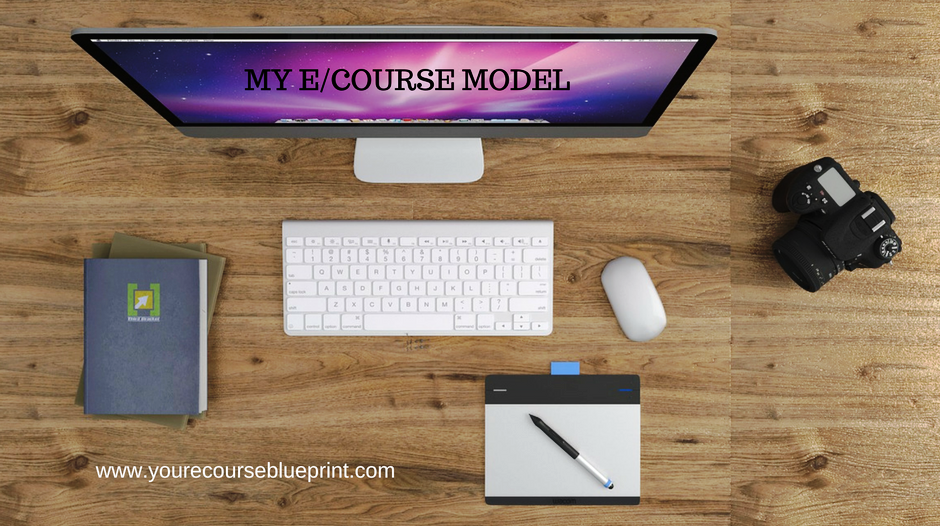KEY ELEMENTS FOR CREATION OF A SUCCESSFUL E/COURSE
Your E/course Model
In this series on “Creativity” in how to create an e/course we are going to start with creating your E/course model.
Before getting into the actual creating of your E/course you can do certain things to begin with which will then enable you to go through each stage of your course creation in a sure and methodical way that ensures the creative process is smooth from start to finish.
An e/course model lays out your course so you can see it and is really the key to creating in the end the type of e/course you feel proud to have created and one that does well in the market. While some may think it’s not necessary to have an e/course model, it is important like in many projects to have the ground work done such as a plan of your E/course. Planning out your course gives you something to work off and guide you and without it can be very difficult in knowing what steps to take each time.
In any sort of work there entails a certain element of preparation and working off a model enables you to see each of the parts involved and what is entailed in working on the details of each part.
An e/course model contains the very key elements and core values of what your course is about. Knowing what the parts are you are then able to fill in the details to as you go along.
Course Preparation.
There are a number of key requirements for building your course. The first one is preparing for your course. This is working out what you want to put in your course and how you’re going to do each section along with considering the other things to do with the material aspects and daily focus on your course creation.
This can include such things as working out your reasons for why you want to create an e/ course. Quite often these can be deep reasons and important ones, so it helps to write them down and use them as motivating factors throughout the creation of your course.
In terms of physical location and health, course environment is an important aspect to consider when doing your course as this can mean working in an area where you have provision made for your course materials and is a suitable place for tapping into your creativity and bringing out your creative powers. You want a place you like that you can call your own to go to whenever you like, with space enough to work unencumbered and suitable enough to bring out your creativity, and explore, and work out different techniques and strategies for your e/course creation.
There are a lot of pieces to put together for an online E/course and all need to be done, so you do need to have a working knowledge and good grounding in how those parts work and go together. For example an e/course model does involve working out your modules and how many you are going to have and the process or order in how you want your course to unfold. It may also include a time frame for how long you want your course to be—you’ll also need to determine the level of your e/course in terms of its costs and value to your customer—then there’s the materials that you’re going to work with and supply to your students.
Key Elements
An e/course model also is composed of main key elements. It’s best to make a diagram up of the elements with a paragraph to briefly describe what each one is about first and how it fits into the big picture. These are the parts of what you’ll be working on in constructing your course. Each part has its details and when you have your E/course model diagram worked out your able to then focus on each as you do them. While your E/course model can be composed of different elements that you personally decide are connected with what your specific course is about they should also relate to a standard E/course model which is composed of elements common to all e/courses.
The diagram of your model doesn’t have to be complicated it can be a simple layout with your key elements as the main areas, with perhaps a small list of the things that you’re going to include or do in that area. For example your key elements may be your product, your market, the type of customer you’re targeting, your course uniqueness, how you’re going to present your course and a group identity element. It may also be split up into sections with so many of the key elements to each section. Really there’s no hard and fast way in creating an E/course model so long as it has the key elements drawn in.
There are a lot of e/course models out there in which you can look and get an idea on how one is created and what the key elements are common to all. Then from that draw up your own diagram and plan which contains basically the sections that denote all the aspects of your e/course from the creation of it right through to how you’re going to put it up online and do the marketing side of it.
To start your e/course project off, first sit down and do a bit of research online and check out some of the other e/course models online and see how they have been done and what the key elements are and then take out a pen and paper and work out your course model plan. That is do your course preparation—insert your key elements, note down the sections and details for each to begin with and then when you are finished, put it all into a folder and bring it out each time when you want to work on your e/course creation. You might want to add bits and pieces here and there to your plan as you go along and get ideas and decide on the things and way you will do it.
If you like to find out more about how to create an e/course model and e/courses then have look at Your E/course Blueprint
________________________________________________________________________





